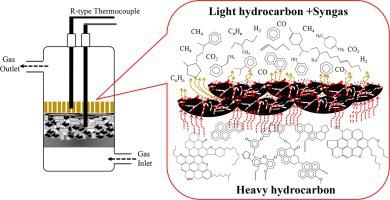Energy Conversion and Management ( IF 9.9 ) Pub Date : 2021-07-14 , DOI: 10.1016/j.enconman.2021.114502 Rubia Idris 1 , William Woei Fong Chong 2, 3 , Atikah Ali 4 , Sidah Idris 5 , Wei Hsiang Tan 1 , Rafidah Md Salim 6 , Guo Ren Mong 7 , Cheng Tung Chong 8

|
Microwave-induced in-situ catalytic co-pyrolysis of empty fruit bunch (EFB) with truck tire (TT) using a low-cost heterogeneous catalyst to produce aromatic-rich pyrolytic oil is proposed. In this study, the effect of catalyst type and catalyst-to-feedstock ratio were investigated. Three types of catalysts were used, namely activated carbon (AC), clay (CL) and calcium oxide (CaO), while the catalyst-to-feedstock ratios of 1:5, 2:5, 3:5 were investigated. Although the catalytic co-pyrolysis significantly reduced the yield, high monoaromatic hydrocarbon fraction and BTEX (benzene, toluene, ethylbenzene, xylene) selectivity were observed in the pyrolytic oil. The study showed that the AC-to-feedstock ratio of 2:5 (AC-0.4) contained a high fraction of monoaromatic hydrocarbon (54.32%) with high selectivity of BTEX (30.42%). The elemental analysis also found the AC catalyst produced hydrogen-rich pyrolytic oil with lower undesirable compounds, mainly from oxygenates (ketone group), nitrogen and sulphur compounds. Moreover, the catalytic co-pyrolysis using AC reduces pyrolytic oil's pH value from 4.7 (un-Cat) to pH 5.02 (AC-0.4). However, the AC catalyst had little effect in increasing the higher heating value (HHV) of pyrolytic oil from 42.29 (un-Cat) to 42.47 MJkg−1 (AC-0.4) with a slightly decreased energy recovery from 62.0% (un-Cat) to 56.5% (AC-0.4). The residual gas analysis determined that the dominant gaseous produced from catalytic cracking using AC were CO2 and CH4. A reaction mechanism between the volatiles of EFB and TT is proposed. Overall, the study has successfully demonstrated an approach for producing pyrolytic oil with high monoaromatic fraction and high selectivity of BTEX from in-situ catalytic co-pyrolysis of EFB with TT using low-cost heterogeneous catalyst.
中文翻译:

通过微波诱导原位催化共热解空果串与废弃卡车轮胎的富含芳烃的热解油
提出了使用低成本多相催化剂对空果串 (EFB) 与卡车轮胎 (TT) 进行微波诱导原位催化共热解,以生产富含芳烃的热解油。在这项研究中,研究了催化剂类型和催化剂与原料比的影响。使用了三种类型的催化剂,即活性炭 (AC)、粘土 (CL) 和氧化钙 (CaO),同时研究了 1:5、2:5、3:5 的催化剂与原料比。尽管催化共热解显着降低了产率,但在热解油中观察到高单芳烃馏分和 BTEX(苯、甲苯、乙苯、二甲苯)选择性。研究表明,活性炭与原料的比例为 2:5 (AC-0.4),其中含有高比例的单芳烃 (54.32%),同时对 BTEX 的选择性高 (30.42%)。元素分析还发现,AC 催化剂产生的富含氢的热解油含有较少的不良化合物,主要来自含氧化合物(酮基)、氮和硫化合物。此外,使用 AC 的催化共热解将热解油的 pH 值从 4.7 (un-Cat) 降低到 pH 5.02 (AC-0.4)。然而,AC 催化剂对将热解油的较高热值 (HHV) 从 42.29 (un-Cat) 提高到 42.47 MJkg 几乎没有影响-1 (AC-0.4),能量回收率从 62.0% (un-Cat) 略微降低到 56.5% (AC-0.4)。残余气体分析确定使用 AC 催化裂化产生的主要气态是 CO 2和 CH 4。提出了EFB挥发物与TT之间的反应机理。总体而言,该研究已成功展示了一种使用低成本多相催化剂通过 EFB 与 TT 的原位催化共热解生产具有高单芳烃馏分和高 BTEX 选择性的热解油的方法。











































 京公网安备 11010802027423号
京公网安备 11010802027423号